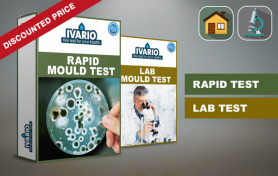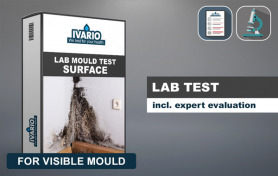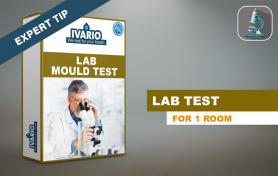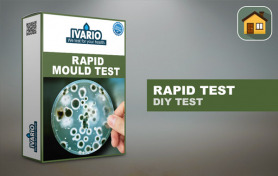Mould Tests

Rapid Mould Tests and Laboratory Analysis
Is there mould in your air at home? Find out now!
- Easy sample collection incl. instructions - no prior knowledge required
- Water analysis in accredited water laboratory DIN-EN ISO 17025
- Fast test results - after just 5-7 days incl. expert tips
Our mould tests for indoor air allow you to measure the type and concentration of mould in the air – either as a home test that you carry out yourself or as a test that you send off for analysis in a lab. If the mould is already visible, our lab test for mould samples makes it possible to investigate and determine a mould sample taken on a material like sellotape (equivalent to the old tape-lift test).
The test results reveal the severity (low to high level of contamination) and can be used to determine the next steps that you need to take, e.g. consulting a mould expert. Mould represents a health risk that should be taken seriously – it is often a cause of allergies and other symptoms. The IVARIO® mould tests give you certainty in just a few steps. No prior knowledge is required.
They are often used to identify mould in the bedroom, mould in the bathroom, mould on windows, walls and in the corners of rooms, as well as general mould in the home.
Some of the most common types of mould found in the home include: hazardous black mould, green mould and white mould. Poisonous yellow and red mould can also appear in rooms in the home. Yet the colour alone is not enough to identify the type of mould that you are dealing with. As there are so many sub-species, specialist laboratories are needed to investigate the correct composition of the mould.
The IVARIO mould tests are recommended by the German Tenants' Protection Association (Deutscher Mieterschutzbund). The reports included with our lab tests can also be used as evidence to show your landlord/property owner and your GP/specialist doctor. Read more
Mould infestation: identify the mould and assess the severity
Mould bacteria and mould fungi can occur in a whole host of places. One of the basic requirements for mould to proliferate is sufficient moisture. If the place in question is damp, then a suspicion of mould in the home or at work is probably not unfounded.
In theory, all materials made from an organic substance can succumb to mould. As such, mould can form and spread exceptionally well on walls, wallpaper, doors and wooden window frames.
There are many different types of mould and some are considerably more dangerous to people and animals than others. The colour of the mould offers some clue as to the type of mould; but it is not sufficient for most people to reliably identify the species. For example, depending on the material and the local conditions, yellow mould can appear brown, and combined moulds are also frequently encountered. A mould test is the ideal solution if mould is suspected or if mould is already visible and you wish to remove it. Mould tests allow you to ascertain the level of risk posed to your health or to rule out any danger and, where necessary, to take the correct steps to combating the mould, for example by consulting a mould expert.
If you are not sure whether mould is even present, it is worth conducting a Mould Home Test Kit for Airborne Mould. This will allow you to ascertain whether the indoor air is contaminated with mould and spores without having to send the results off for laboratory analysis.
If you already know that you have a case of airborne mould, the Lab Mould Test for Airborne Mould is ideal for accurately identifying which types of mould are present and in which concentrations. You can use this information to correctly assess the danger and to decide how best to combat the mould.
On the other hand, if your mould is already visible and you want to identify the mould and the risk it poses, you can use the IVARIO . A strip of adhesive tape (similar to a tape-lift test) is used to take a mould sample and this is then sent to the lab for analysis and identification.
Mould and your health: how dangerous is mould?
Mould is a problem that needs to be taken seriously. It is especially dangerous for families with children, asthmatics, those with a weakened immune system and older people. But mould can pose a serious threat to healthy adults too.
According to the German Federal Environment Ministry, it has been proven that children who grow up in rooms with visible mould suffer from adverse effects to the development of their health. There is also evidence that shows a correlation between mould and asthma – both in terms of the condition developing and worsening. Mould can lead to respiratory infections, coughs, wheezing and shortness of breath, and it is suspected to be a cause of bronchitis and allergic rhinitis (hayfever).
As mould often occurs in places suffering from damp, illnesses caused by mould can also include symptoms such as a cough, headache or fatigue, which can have a considerable lasting impact on quality of life.
With this in mind, if you suspect mould in your home or office, you should act fast. If the mould is visible, you should send off a mould sample for investigation. IVARIO’s Lab Test for Walls and Surfaces involves using a strip of adhesive tape (similar to a tape-lift test) to take a mould sample and then sending the sample to the laboratory for analysis and identification.
Where does mould occur?
Mould caused by the fabric of a building and its interior spaces tends to occur in areas with a high transfer of heat or in places where large amounts of moisture form.
Mould due to insufficient insulation
Mould can develop in places with insufficient insulation. This is most noticeable on external walls with inadequate insulation, as the temperature on the inside of the external wall can cool down extremely fast in autumn and winter, causing condensation.
Mould on thermal bridges
Similar to external walls, mould can also form on thermal bridges. Thermal bridges tend to be ceilings, floors and internal walls. Mould can grow extremely quickly in places where there is a large difference in temperature between two rooms, leading to lots of condensation forming. As such, mould regularly forms in corners, as they often represent complex thermal bridges.
Mould forming on thermal resistances
Thermal resistances can be items of furniture, textiles, curtains and other objects that can retain heat. Air can reach the gaps between the resistances and the walls or floor, but relatively little heat can get in to these spaces. This in turn leads to condensation and moisture, which is highly conducive to mould growth.
Mould in rooms with high moisture levels
Some rooms generally have a high level of moisture. This is why mould is often found in kitchens, bedrooms, bathrooms and conservatories. In most cases, correct ventilation and heating can prevent many issues. Despite this, these rooms have a higher level of risk – mould is pretty much a given in poorly ventilated bathrooms and bedrooms. It is definitely worthwhile using a mould test or mould analysis kit to check whether mould is present and, if so, which type of mould you are dealing with.
Mould as a result of water damage
Mould can easily form in areas that have been subject to water damage. It is often worth conducting a mould test here prior to renovation work taking place. This ensures that there are no remnants of the mould infestation, which could lead to long-term issues and impact the quality of the air or the substance of the building.
Types of mould
Mould comes in a range of colours and it can grow on a wide range of materials. Although the colour can provide a clue as to which type of mould you are dealing with, it is nevertheless advisable to conduct a lab mould test to find out the precise type of mould present.
Generally speaking, we differentiate between the following types of mould:
Black mould
Black mould generally forms as a result of very high air humidity levels and, as such, is commonly found on windows, bathroom tiles or wallpaper near windows. However, it can also appear on walls, doors and in other places. As with all types of mould, there are several sub-species of black mould and some of these can quickly lead to health problems, such as Aspergillus niger or Alternaria alternata. A Lab Mould Test is, therefore, a good investment, whether it be for the air itself or for a material sample. It will inform you which type of mould you are dealing with and how the specific mould can impact on your health.
Red mould
When it comes to red mould, many people think of bright red, like the kind you see in traffic lights. But red mould can come in a range of shades. The mould ranges in colour from light pink to bright red, from rusty red to rusty brown, and from orange to burgundy. Red mould is often found in conjunction with black or white mould. To the untrained eye, red mould on the wall can look like spots of rust, especially when you are not familiar with the room in question. In this case, it is worth arranging for a laboratory mould test to ascertain whether the red mould is the fairly harmless Neurospora crassa or a more dangerous sub-species like Fusarium.
White mould
White mould is inconspicuous by nature. Thanks to its colour, it tends to remain hidden for a long time when it arises on walls, window ledges, window frames etc. It doesn’t tend to develop a strong smell, so it often remains undiscovered, or you simply get used to the room’s slight change in smell. White mould is often confused with other issues, which may look similar to the untrained eye. These include efflorescence caused by salt or limescale, dry rot or saltpeter. A lab mould test can be a great way of finding out whether the indoor air contains different types of white mould or to investigate a suspicious material more closely.
Green mould
Most people are familiar with green mould – it is often found on fruit or bread, especially in the summertime when air humidity meets high temperatures and food tends to go off more quickly. But walls, doors and windows can also be affected. The most common type of green mould is Aspergillus fumigatu, which is part of the Aspergillus genus and is known for its mycotoxins, which can lead to allergies, lung disorders and aspergillosis. If you suspect green mould in your home or if you can see it, we highly recommend carrying out a lab mould test to identify the type of mould and discuss the best ways to combat it with a specialist.
Yellow mould
Yellow mould is often confused with dry rot but is actually quite different. It tends to affect soil and plants and is often found in association with these. The exception here is the sub-species Geomyces pannorum, which can also grow on walls, wallpaper and wood. If you are not sure whether you are dealing with dry rot or yellow mould, a mould lab test kit can be an accurate way of identifying the problem.
Mould tests made easy – with IVARIO
If you want to know whether you have mould in your home or what type of mould you have, then a mould test is the best option. Once you have ordered your mould test kit, it will be delivered within 24 hours, Monday to Friday. Thanks to the sophisticated test kits, you don’t need any prior knowledge to conduct a mould test in your home. If you opt for a lab analysis, simply send the sample or petri dishes to our German specialist laboratory. Your mould sample will be analysed within just a few days. As soon as the results are available, they will be emailed directly to your inbox, or can be sent by post.
Laboratory analysis of mould samples
All IVARIO mould tests are conducted in accredited German specialist laboratories and analysed by experts. Thus, you don’t just receive a reliable result telling you which type of mould you have; we also send detailed information about what could have caused the mould infestation in the first place. This information is particularly important if you want to present the results of your mould test to a (specialist) doctor to protect your health. It is also extremely useful when it comes to identifying the origin of the mould on your walls, windows or ceilings.
CloseCOMPLETE
WALLS and SURFACES
LAB TEST
RAPID TEST
Mould information
Mould infestation: identify the mould and assess the severity
Mould bacteria and mould fungi can occur in a whole host of places. One of the basic requirements for mould to proliferate is sufficient moisture. If the place in question is damp, then a suspicion of mould in the home or at work is probably not unfounded.
In theory, all materials made from an organic substance can succumb to mould. As such, mould can form and spread exceptionally well on walls, wallpaper, doors and wooden window frames.
There are many different types of mould and some are considerably more dangerous to people and animals than others. The colour of the mould offers some clue as to the type of mould; but it is not sufficient for most people to reliably identify the species. For example, depending on the material and the local conditions, yellow mould can appear brown, and combined moulds are also frequently encountered. A mould test is the ideal solution if mould is suspected or if mould is already visible and you wish to remove it. Mould tests allow you to ascertain the level of risk posed to your health or to rule out any danger and, where necessary, to take the correct steps to combating the mould, for example by consulting a mould expert.
If you are not sure whether mould is even present, it is worth conducting a Mould Home Test Kit for Airborne Mould. This will allow you to ascertain whether the indoor air is contaminated with mould and spores without having to send the results off for laboratory analysis.
If you already know that you have a case of airborne mould, the Lab Mould Test for Airborne Mould is ideal for accurately identifying which types of mould are present and in which concentrations. You can use this information to correctly assess the danger and to decide how best to combat the mould.
On the other hand, if your mould is already visible and you want to identify the mould and the risk it poses, you can use the IVARIO . A strip of adhesive tape (similar to a tape-lift test) is used to take a mould sample and this is then sent to the lab for analysis and identification.
Mould and your health: how dangerous is mould?
Mould is a problem that needs to be taken seriously. It is especially dangerous for families with children, asthmatics, those with a weakened immune system and older people. But mould can pose a serious threat to healthy adults too.
According to the German Federal Environment Ministry, it has been proven that children who grow up in rooms with visible mould suffer from adverse effects to the development of their health. There is also evidence that shows a correlation between mould and asthma – both in terms of the condition developing and worsening. Mould can lead to respiratory infections, coughs, wheezing and shortness of breath, and it is suspected to be a cause of bronchitis and allergic rhinitis (hayfever).
As mould often occurs in places suffering from damp, illnesses caused by mould can also include symptoms such as a cough, headache or fatigue, which can have a considerable lasting impact on quality of life.
With this in mind, if you suspect mould in your home or office, you should act fast. If the mould is visible, you should send off a mould sample for investigation. IVARIO’s Lab Test for Walls and Surfaces involves using a strip of adhesive tape (similar to a tape-lift test) to take a mould sample and then sending the sample to the laboratory for analysis and identification.
Where does mould occur?
Mould caused by the fabric of a building and its interior spaces tends to occur in areas with a high transfer of heat or in places where large amounts of moisture form.
Mould due to insufficient insulation
Mould can develop in places with insufficient insulation. This is most noticeable on external walls with inadequate insulation, as the temperature on the inside of the external wall can cool down extremely fast in autumn and winter, causing condensation.
Mould on thermal bridges
Similar to external walls, mould can also form on thermal bridges. Thermal bridges tend to be ceilings, floors and internal walls. Mould can grow extremely quickly in places where there is a large difference in temperature between two rooms, leading to lots of condensation forming. As such, mould regularly forms in corners, as they often represent complex thermal bridges.
Mould forming on thermal resistances
Thermal resistances can be items of furniture, textiles, curtains and other objects that can retain heat. Air can reach the gaps between the resistances and the walls or floor, but relatively little heat can get in to these spaces. This in turn leads to condensation and moisture, which is highly conducive to mould growth.
Mould in rooms with high moisture levels
Some rooms generally have a high level of moisture. This is why mould is often found in kitchens, bedrooms, bathrooms and conservatories. In most cases, correct ventilation and heating can prevent many issues. Despite this, these rooms have a higher level of risk – mould is pretty much a given in poorly ventilated bathrooms and bedrooms. It is definitely worthwhile using a mould test or mould analysis kit to check whether mould is present and, if so, which type of mould you are dealing with.
Mould as a result of water damage
Mould can easily form in areas that have been subject to water damage. It is often worth conducting a mould test here prior to renovation work taking place. This ensures that there are no remnants of the mould infestation, which could lead to long-term issues and impact the quality of the air or the substance of the building.
Types of mould
Mould comes in a range of colours and it can grow on a wide range of materials. Although the colour can provide a clue as to which type of mould you are dealing with, it is nevertheless advisable to conduct a lab mould test to find out the precise type of mould present.
Generally speaking, we differentiate between the following types of mould:
Black mould
Black mould generally forms as a result of very high air humidity levels and, as such, is commonly found on windows, bathroom tiles or wallpaper near windows. However, it can also appear on walls, doors and in other places. As with all types of mould, there are several sub-species of black mould and some of these can quickly lead to health problems, such as Aspergillus niger or Alternaria alternata. A Lab Mould Test is, therefore, a good investment, whether it be for the air itself or for a material sample. It will inform you which type of mould you are dealing with and how the specific mould can impact on your health.
Red mould
When it comes to red mould, many people think of bright red, like the kind you see in traffic lights. But red mould can come in a range of shades. The mould ranges in colour from light pink to bright red, from rusty red to rusty brown, and from orange to burgundy. Red mould is often found in conjunction with black or white mould. To the untrained eye, red mould on the wall can look like spots of rust, especially when you are not familiar with the room in question. In this case, it is worth arranging for a laboratory mould test to ascertain whether the red mould is the fairly harmless Neurospora crassa or a more dangerous sub-species like Fusarium.
White mould
White mould is inconspicuous by nature. Thanks to its colour, it tends to remain hidden for a long time when it arises on walls, window ledges, window frames etc. It doesn’t tend to develop a strong smell, so it often remains undiscovered, or you simply get used to the room’s slight change in smell. White mould is often confused with other issues, which may look similar to the untrained eye. These include efflorescence caused by salt or limescale, dry rot or saltpeter. A lab mould test can be a great way of finding out whether the indoor air contains different types of white mould or to investigate a suspicious material more closely.
Green mould
Most people are familiar with green mould – it is often found on fruit or bread, especially in the summertime when air humidity meets high temperatures and food tends to go off more quickly. But walls, doors and windows can also be affected. The most common type of green mould is Aspergillus fumigatu, which is part of the Aspergillus genus and is known for its mycotoxins, which can lead to allergies, lung disorders and aspergillosis. If you suspect green mould in your home or if you can see it, we highly recommend carrying out a lab mould test to identify the type of mould and discuss the best ways to combat it with a specialist.
Yellow mould
Yellow mould is often confused with dry rot but is actually quite different. It tends to affect soil and plants and is often found in association with these. The exception here is the sub-species Geomyces pannorum, which can also grow on walls, wallpaper and wood. If you are not sure whether you are dealing with dry rot or yellow mould, a mould lab test kit can be an accurate way of identifying the problem.
Mould tests made easy – with IVARIO
If you want to know whether you have mould in your home or what type of mould you have, then a mould test is the best option. Once you have ordered your mould test kit, it will be delivered within 24 hours, Monday to Friday. Thanks to the sophisticated test kits, you don’t need any prior knowledge to conduct a mould test in your home. If you opt for a lab analysis, simply send the sample or petri dishes to our German specialist laboratory. Your mould sample will be analysed within just a few days. As soon as the results are available, they will be emailed directly to your inbox, or can be sent by post.
Laboratory analysis of mould samples
All IVARIO mould tests are conducted in accredited German specialist laboratories and analysed by experts. Thus, you don’t just receive a reliable result telling you which type of mould you have; we also send detailed information about what could have caused the mould infestation in the first place. This information is particularly important if you want to present the results of your mould test to a (specialist) doctor to protect your health. It is also extremely useful when it comes to identifying the origin of the mould on your walls, windows or ceilings.












